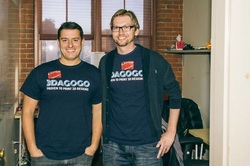|
Every startup will have a passionate entrepreneur behind it who fell in love with an idea enough to give it his all. But to succeed, that is not enough. Others have to fall in love with your idea too. Others include investors. Here are the top traits that emerged out of the discussions. These are 3 key questions investors will seek answers from entrepreneurs before deciding on funding the startup.
1) Do you have the guts and drive to cross the dark valley? “When an entrepreneur succeeds, there is so much glamour and halo attached to them. What is forgotten or undervalued is the walk through the dark valley entrepreneurs go through,” Vani Kola, Managing Director, Kalaari Capital, told us. Before she became a VC, Vani Kola had built two successful companies in Silicon Valley and exited them with billion-dollar valuation. “There are times when you can’t access capital, nobody believes in your idea, and even when you are winning or think you are winning, nobody really gives any value to the growth you are creating. Sometimes you don’t know how in the next six months you can take your business to the next level. There are so many lonely, dark spots in the growing of your business. As I have experienced those personally, I look at an entrepreneur and see, do they have the guts and drive inside them to cross that black hole? Will they get consumed by that? Will they quit or will they persevere?” This is one quality she looks for in an entrepreneur. “That elusive quality of perseverance — People who can compartmentalise these inevitable problems, which are costs every entrepreneur has to bear, and have immense faith on their product or service, and have a deep passion to pursue it — is something that I, having been an entrepreneur myself, empathise with. On the days things don’t go great, this quality will see the entrepreneur through,” she says. 2) Can you transmit your passion and faith to the investor? At the stage of seed and series A round of funding, an entrepreneur doesn’t have the numbers to back him, and therefore investors have a tough decision before them. “You don’t know whether the business will take off or taper off; you don’t know whether the entrepreneur who delivered the business from ten thousand to five millions can actually build a business that looks like it can go to 50 millions. You don’t know whether the team is fully in place to do that. You don’t know whether the market sizing is yet niche or is it going to grow to a 20 million or is it going to cross that 100 million mark which everybody is looking for. And therefore an investor is far more hesitant,” explains Karthik Reddy, co-founder and managing partner of Blume Ventures. “The investors who eventually end up cutting the cheque are those who become equally passionate about solving all those questions. They see that spark in the entrepreneur. They see that market opportunity, just as the entrepreneur sees it. At seed, it is probably an extreme version of that shared passion and faith.” 3) How good is your team or can you build a great team? However good your product is, however good a coder or business head you are, without a complimentary team member or without the ability to build a great organisation you are not going to survive and make it to series A, Karthik Reddy says. “The learning from three years of seed investing is that the team is more important in our evaluation matrix as we mature as a fund. Without a good team, even if you somehow make it to series A, you are probably going to falter before you get to series B, leave alone grand hundred million exit stories.” According to him, investors should walk away from the opportunity, however best the idea might be or however much they relate to the idea if the team isn’t strong enough or the entrepreneur looks unlikely to be a good team leader. “After all, an investor is not going to run the startup for the entrepreneur. So fundamentally, if they are not going to make their business work themselves, you shouldn’t invest in it.” _____________________________________________________________________________________ This is an edited version of a post originally posted at yourstory.com, by Malavika Velayanikal is Executive Editor of YourStory.com and Innovation Junkie. You are free to re-edit and repost this in your own blog or other use under Creative Commons Attribution 3.0 License terms, by giving credit with a link to www.startupcommons.org and the original post. It is very typical to measure mature of startups ecosystems in terms of new startups, growing startups, investors, investments, exits, etc. and it makes sense as cities use these statistics in the best possible way to communicate their economic growth at high level and to attract other relevant people, investors, big companies, more entrepreneurs and other stakeholders. These indicators are however the result of many smaller activities present in a startup ecosystem that contribute to these higher level results - as any startup ecosystem is the sum of multiple variables of an unbalanced equation inherent to the interactions of the startup ecosystem itself. So, as you can figure out, you need much information to talk about matureness of startups ecosystems. But most of all, you need a good understanding and analysis of your startup ecosystem at different levels and mapping it usually is a good starting point to set up new strategies and achieve a better economic development. But the thing is that properly mapping a startup ecosystem is more than just to create a good map to show who is who in your city or region. It is crucial to work at different levels and in more detail:
We truly believe everyone should work on this model, as it makes the investments to growth and innovation truly visible and measurable - as only the things that can be measured can be improved. And the faster the feedback loop, the faster things can be improved. Actually we are working with this model with few key cities like Helsinki at ecosystem level and even more broadly with independent organizations and we are clearly seeing that it is possible to build a vibrant startup ecosystem in a city in three to five years, what is half or less, compared to known average. Future entrepreneurs and current startups deserve this new scenario that we at Startup Commons are creating and we encourage others to contribute and develop innovation, better, faster and with less resources. Are you a consultant or an entrepreneur? - Learn more about Growth Academy Online Training & Certification Programs Download our startup booklet and watch our videos to learn more about our framework to help startups to grow without "reinventing the wheel" and without wasting lot of time trying to connect the dots. The framework is based on the startup development phases and aims to remove the highest universal risks on the startup journey. This is an originally posted by Óscar Ramírez, CEO Startup Commons. You are free to re-edit and repost this in your own blog or other use under Creative Commons Attribution 3.0 License terms, by giving credit with a link to www.startupcommons.org and the original post
 If you’re an early-stage startup that’s looking for a little help to get your business off of the ground, look no further than the recently established Founders Space accelerator and incubator. Founders Space, which was just opened a week ago, has already made it a point to provide some of the best perks and opportunities for its participants, including seminars, networking events, pitch competitions, and access to amazing set of experienced advisors, VCs, and angel investors. In San Francisco, startup accelerators are fairly easy to come by – just Google it. However, few offer their participants the comprehensive package that Founders Space has put together. Thanks to founders Steve Hoffman and Murray Newlands, Founders Space has managed to assemble an impressive experience for early-stage companies that focuses on the development of their brand, their product, and achieving their business objectives.
The way it works is really quite simple, too. Startups can apply to join Founders Space, and once they’re accepted, they will go through an intensive 4-week “Boot Camp” where they will attend sessions taught by experienced industry professionals, along with networking events where they will be introduced to relevant VCs and angel investors. “We are looking for companies that we truly believe in to join Founders Space because we have a dedicated and experience group of advisors and investors who are ready to take on the next big thing,” Steve Hoffman said. “Our goal is to teach these early-stage companies everything they need to know and introduce them to the right people to help them get things going and become the next major enterprise.” For early-stage startups, the Founders Space location couldn’t be in a better location, either. The co-working space is situated in the heart of SF’s tech industry at SOMA Central, the same building where Instagram, Twilio, and a handful of other successful companies originally got their start. “We’ve got a great co-working space in SOMA that encourages and inspires collaboration, but also enables our startups to have the meetings and business events that they need to,” said Murray Newlands. “Once we start our accelerator program, we plan on having regular networking events and seminars to give our startups the opportunities to learn and connect with other people in the industry.” If you’re interested in learning more about Founders Space or applying for their program, be sure to visit their website for more information. ___________________________________________________________________________________________ This is an edited version of an post originally posted at yourstory.com, by Chandan Raj, CTO at YourStory. Apart from tech -learning and sharing about founders, innovators and changemakers psyche and natural system evolution. You are free to re-edit and repost this in your own blog or other use under Creative Commons Attribution 3.0 License terms, by giving credit with a link to www.startupcommons.org and the original post. Many a time, entrepreneurs, in their rush to see their ideas take form, miss out on getting their legal affairs in order. Look at it as a necessary evil, if you will, but there are certain agreements that an entrepreneur simply must not ignore. 1) Founder Agreements Depending on the choice of entity, and without prejudice to the camaderie among the founders, it is essential to execute a founder’s agreement. If the chosen form of the entity is a partnership, ensure that your partnership agreement is in place. This contract sets out in clear terms the understanding that the partners must have in order to run the desired business. Typically the clauses include the capital invested by the founders, owner of the intellectual property and whether it may be licensed, terms relating to issue of shares at a later point in time, exit clauses, and other specifics that can clear any potential ambiguity. While it’s all good to say that an oral agreement is more than enough and business is based on mutual trust, some entrepreneurs have learnt the importance of this document the hard way. It is not unheard of that companies close operations and write away an idea forever because of founder disputes on IP or because of differences on how an exit opportunity must be valued. 2) Charter Documents Charter documents include the Memorandum of Association (MoA) and the Articles of Association (AoA) that contain the basic information regarding the Company. The MoA contains information relating to incorporation details, share capital, members’ liability, etc. The AoA contains the regulations governing the management of the Company like information regarding general meetings, Board of Directors, proceedings by the Board and details on voting rights. . 3) Trademark License Agreements Such an agreement is necessary for a company and its founders so that the company owns a trademark (or has filed an application with the trademark registry). This contract sets down the rightful owner of the IP, his protected rights and the rights that will be offered to the user of the brand. An agreement of this kind is useful for start-up companies dealing with products and services (restaurants, food business, clothes, etc) as they look to build a brand. In some cases, an entrepreneur may opt for the franchisee route to market his products or services in which case the considerations are different from vanilla company brand owners.. 4) Employment Agreement It is necessary to establish the rights and obligations of employees and this can have varied benefits. If the company is working in an area that uses heavy IP or human resources, it is crucial to include IP protection clauses, non-compete and non-solicit clauses in the employment agreements. At a later date, it assists an entrepreneur in that he is not entangled in an IP theft or competitors poaching his talent. Note, even if the founder is appointed as a managing director (MD), it is good to have an agreement in place. The new Companies Act provides that the terms and conditions of appointing an MD must be stated in the board /shareholder resolution itself. Compliances with newer laws such as prevention of sexual harassment at the work place, trading in securities, prevention of corrupt practices and so on make this exercise of compliance a good corporate habit. 5) Share Subscription This agreement sets out the details regarding the ownership of shares, and the resulting representation rights of each of the shareholders along with the terms and conditions in the event of a future exit or sale of shares. This lists out the conditions required in the event of termination, the obligations of an investors and other shareholders at the time of raising a round of capital and at the time of exit during a capital event. ,.It is the document that binds all activities inter-se shareholders and governs the shareholder rights in a play of capital. The practices and considerations in negotiating and finalizing this document is an art as well as a craft that is becoming very sophisticated and requires due consideration from the Founders . This is an edited version of an post originally posted at yourstory.com, by Harini Subramani, a Consultant at J. Sagar Associates. You are free to re-edit and repost this in your own blog or other use under Creative Commons Attribution 3.0 License terms, by giving credit with a link to www.startupcommons.org and the original post.
 3DaGoGo Team: Daniel & Josh 3DaGoGo Team: Daniel & Josh Daniel Arroyo is very clear. Only through entrepreneurship has managed to enjoy what he really likes. In his case, from San Diego building software for the startup 3DaGoGo, a marketplace in commitment stage for proven to print 3D designs. Daniel occasionally blogs at danielarroyo.net. Describe 3DaGoGo in under 50 words 3DaGoGo simplifies the complex world of 3D printing software into a simple 1-click-print experience, making it easy for anyone to print an object on a 3D printer from any computer or mobile device. Tell us the 3DaGoGo story. How and why was this project born? 3DaGoGo was born out of frustration when Drew (our CEO) wanted to create a customizable medical device using 3D Printing technology. We saw both the potential and challenges of this amazing technology and started working on solving the problem of failed prints by creating a marketplace of “proven-to-print” designs. It soon became clear to us that the problem had to be tackled at its core: The overly complicated software chain used to get a design into the printer. We are now part of the Betaspring technology accelerator building a software platform that simplifies this software from over 120 settings into 3 (printer, material & quality) and allows 1-click-printing over the internet with a beautiful user interface. Everybody is crazy with 3D. How does 3DaGoDo see 3D revolution? Where do you see many opportunities for startups? Disney expects a 3D Printer in every home in about 10 years. We believe it should be sooner. While not everything will be manufactured at home, we see a future where a big portion of the things we use are going to come to us in the form of digital files that can be brought to life by a 3D printer. A world in which making items that are highly customized is only a few clicks away. Toys and replacement parts will be available for sale in online storefronts for under $5 in digital format and with options to customize them. While it is still a bit early to start building solutions for the general consumer in this space, the infrastructure land grab has already started. We see huge opportunities for innovative startups with middleware or infrastructure software in marketplaces, 3D file creation tools, 3D design processing and validation as well as printer drivers. The hardware opportunities abound as well. These machines should be made simpler to use with less maintenance, more durability and better resolution. There are plenty of innovation to be made in these areas. Also bringing other 3D printing technologies like powder-based printers to the under $1,000 is something we’re looking forward to as well. What is the most challenging part of building 3DaGoGo? We are working with highly sophisticated and complicated software while at the same time offering an extremely simple user interface. Making it simple for the user, always means making it 3 times harder for us. There are plenty of product discussions where the easiest way out would be to just make it a little harder for the user so that we can build faster and with less complications. We strive to avoid making these trade-offs and in almost every case choose to make harder on ourselves instead.  Screenshot of 3DaGoGo product Screenshot of 3DaGoGo product What technologies have you used to build 3DaGoDo? What was technically the most challenging part of developing 3DaGoGo? It’s a broad range as we use a few open source projects as a base for our efforts. Most of our web and api server code is written in PHP accelerated by the Phalcon framework. We provide slicing capabilities using Slic3r which uses Perl. Our printer controller interface is built in Python since OctoPrint used that and we’re based on it. Thus far the most technically challenging part has been to make Slic3r reliably and scalably run in the cloud. This was a software program made to run on a computer and making it run on a sever that can process 1000s of requests was not an easy task. Are you receiving the support of any mentor for your startup? If so, how is the relationship with him/her? We are part of Betaspring, a technology accelerator in the US and have also graduated from SpringBoard Connect. We are receiving plenty of mentorship along the way. In some cases advice is contradictory with our views or with other mentors. It’s the job of the team to take ALL advice into consideration, carefully think about it and respectfully discard what doesn’t make sense in the context of the team’s values and beliefs. In addition we’re in a complex and relatively unknown space, so often the advice is related to parallel industries or analogs and have to “translated” into our situation. We have found great mentors and advisors that believe in our vision and the potential of our industry. The challenge is to narrow down the list of mentors and advisors to those that would enjoy and benefit from the relationship as much as we do. What kind of partnerships are you achieving or building? We’re working on partnerships with 3D Printer manufacturers. We see ourselves as the solution that would allow them to grow out of the current early adopter, super-hacker types that enjoy tinkering with open source software. The next wave of consumers that just want to experience this technology is patiently waiting for our solution. They don’t have the time or interest to spend whole weekend trying to figure out how to successfully print one object. We want printer manufactures to focus on solving the hardware problems of 3D Printers while we help them delight their customers with software that is easy, beautiful and intuitive. In addition, we’re forging deep relationships with the current open source community that has developed most of the software used today. We ourselves complementing their mission by adding a layer of simplicity to their offerings so that they can reach a previously unimaginable number of people. You are based in San Diego, California. What’s the startup ecosystem like there? It’s not Silicon Valley (nor does it need to be) but it’s growing and very vibrant. There are many new startups popping up in the downtown district. I have been involved in San Diego startups since early 2011 and I have seen tremendous growth. The entrepreneurial network is amazing, full of people willing to help, meet and discuss their ideas. However, the overall business community is still dominated by big corporation (mainly biotech) and capital is hard to come by. If you could come back to the past, what would you do differently in your startup? We’re still early and while we have done some mistakes, I don’t think that I would really would have wanted to do anything different as they have all taught us something and taken us to where we are. If anything, I wish we had started earlier, but that will always be the case. Your big mistake? 3DaGoGo has yet to make it (and I’m sure it will). Nothing thus far as been a catastrophic mistake. Personally, I wish I had started working in startups way earlier than I did. I have always been an entrepreneur though it took me a while to fully realize it. While going to college in Spain, I made software for Real Estate Agents, a web platform for movie theaters and accounting software as freelance. I then took an 11 year detour into the world of big tech corporations (Nokia, Qualcomm) only to return to what makes me happy in 2011. What one piece of advice would you like to give to those who want to transform an idea into a business? Start today, not tomorrow or next week. TODAY! Start by telling everybody about your idea. Recruit cofounders, mentors and advisors. The more people you tell, the more real it becomes. Never forget that ideas don’t make a business, execution does. The sooner you get to the execution part, the sooner you’ll know if you idea is any good. |
Supporting startup ecosystem development, from entrepreneurship education, to consulting to digital infrastructure for connecting, measuring and international benchmarking.
Subscribe for updates
Startup ecosystem development updates with news, tips and case studies from cities around the world. Join Us?Are you interested to join our global venture to help develop startup ecosystems around the world?
Learn more... Archives
December 2023
Categories
All
|
- Startup Commons
- Business Creators
-
Support Providers
- About Support Providers
- Learn About Startup Ecosystem
- Startup Development Phases
- Providing Support Functions
- Innovation Entrepreneurship Education
- Innovation Entrepreneurship Curriculum
- Growth Academy eLearning Platform
- Certified Trainers
- Become Growth Academy Provider In Your Ecosystem
- Growth Academy Training On-Site By Startup Commons
-
Ecosystem Development
- About Ecosystem Developers
- What Is Startup Ecosystem
- Ecosystem Development
- Ecosystem Development Academy eLearning Platform
- Subscribe to Support Membership
- Ecosystem Operators
- Development Funding
- For Development Financiers
- Startup Ecosystem Maturity
- Case Studies
- Submit Marketplace App Challenge
- Become Ecosystem Operator
- Digital Transformation
- Contact Us
- Startup Commons
- Business Creators
-
Support Providers
- About Support Providers
- Learn About Startup Ecosystem
- Startup Development Phases
- Providing Support Functions
- Innovation Entrepreneurship Education
- Innovation Entrepreneurship Curriculum
- Growth Academy eLearning Platform
- Certified Trainers
- Become Growth Academy Provider In Your Ecosystem
- Growth Academy Training On-Site By Startup Commons
-
Ecosystem Development
- About Ecosystem Developers
- What Is Startup Ecosystem
- Ecosystem Development
- Ecosystem Development Academy eLearning Platform
- Subscribe to Support Membership
- Ecosystem Operators
- Development Funding
- For Development Financiers
- Startup Ecosystem Maturity
- Case Studies
- Submit Marketplace App Challenge
- Become Ecosystem Operator
- Digital Transformation
- Contact Us




 RSS Feed
RSS Feed

